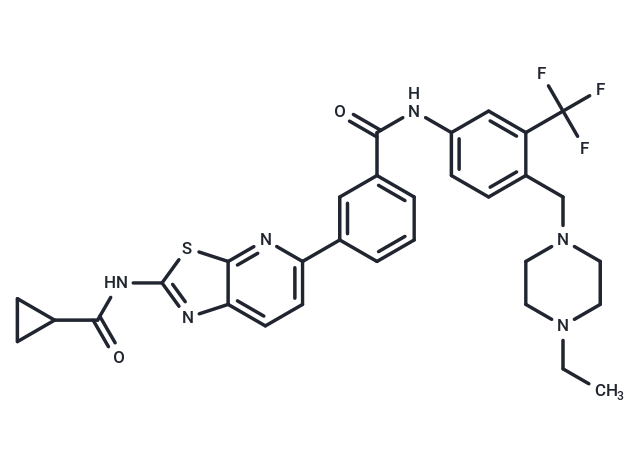Shopping Cart
- Remove All
 Your shopping cart is currently empty
Your shopping cart is currently empty

HG-7-85-01 is a type II ATP competitive inhibitor targeting wild-type and gatekeeper mutations of Bcr-Abl, PDGFRα, Kit, and Src kinases. It effectively inhibits T315I mutant Bcr-Abl kinase, as well as KDR and RET kinases with IC50 values of 3 nM, 20 nM, and 30 nM, respectively. HG-7-85-01 exhibits weak or no inhibition towards other kinases (IC50 >2 μM). Additionally, this compound inhibits cell proliferation by inducing apoptosis and impeding cell-cycle progression.

| Pack Size | Price | Availability | Quantity |
|---|---|---|---|
| 5 mg | $970 | Backorder |
| Description | HG-7-85-01 is a type II ATP competitive inhibitor targeting wild-type and gatekeeper mutations of Bcr-Abl, PDGFRα, Kit, and Src kinases. It effectively inhibits T315I mutant Bcr-Abl kinase, as well as KDR and RET kinases with IC50 values of 3 nM, 20 nM, and 30 nM, respectively. HG-7-85-01 exhibits weak or no inhibition towards other kinases (IC50 >2 μM). Additionally, this compound inhibits cell proliferation by inducing apoptosis and impeding cell-cycle progression. |
| Targets&IC50 | BCR-ABL (T315I):3 nM (IC50), RET:30 nM (IC50), KDR:20 nM (IC50), PDGFRα:440 nM (IC50), MK5:560 nM (IC50), JAK1:120 nM (IC50) |
| In vitro | Treatment with HG-7-85-01 (0-1 µM) for 24 hours on cells expressing BCR-ABL, BCR-ABL-T315I, Kit-T670I, PDGFRα-T674M, and PDGFRα-T674I results in G0G1 cell cycle arrest of those expressing BCR-ABL[1]. A similar treatment for 72 hours induces apoptosis in BCR-ABL-expressing cells[1]. HG-7-85-01 effectively and selectively hampers the proliferation of 32D and Ba/F3 cells harboring the nonmutant BCR-ABL and BCR-ABL-T315I gatekeeper mutation, demonstrating higher efficiency against the nonmutant and T315I mutant forms of BCR-ABL (IC 50 = 0.06-0.14 µM)[1]. It also restricts BCR-ABL kinase activity in a dose-dependent manner, reinforcing the specific targeting of BCR-ABL kinase as its action mechanism[1]. The compound robustly suppresses the proliferation of Ba/F3 cells expressing Kit-T670I mutation and cells expressing TEL/PDGFRβ, but not the parental Ba/F3 cells. It concentration-dependently inhibits Kit and PDGFR phosphorylation[1]. PDGFRα gatekeeper mutations T674M and T674I are particularly sensitive to HG-7-85-01, and significant rescue with IL-3 was noted[1]. Furthermore, it curtails the proliferation of Ba/F3 cells transformed with human c-Src and its mutants (EC 50 for T338I Src = 290 nM; T338M Src = 150 nM), and effectively inhibits the growth of cells expressing exon 11 Kit mutation, while those with exon 9 Kit mutation show lesser responsiveness[1]. Cell Cycle and Apoptosis Analyses showed that HG-7-85-01 led to G0G1 cell cycle arrest and induced apoptosis in BCR-ABL-expressing cells at concentrations ranging from 0 to 1 µM over 24 and 72 hours, respectively[1]. |
| In vivo | HG-7-85-01 exhibits restricted oral bioavailability, demonstrated by its absorption rates in mice (BAV % F mouse = 5%) and rats (19%). It maintains a moderate half-life (T 1/2 mouse = 1.1 hours; rat = 5.8 hours) alongside a relatively low peak serum concentration (C max mouse = 106 ng/mL at 10 mg/kg; rat = 292 ng/mL at 2 mg/kg). Moreover, this compound is characterized by its considerable clearance rates (Cl mouse = 23 ml/min/kg; rat = 13 ml/min/kg)[1]. |
| Molecular Weight | 608.68 |
| Formula | C31H31F3N6O2S |
| Cas No. | 1258391-13-7 |
| Storage | Powder: -20°C for 3 years | In solvent: -80°C for 1 year | Shipping with blue ice. |

Copyright © 2015-2025 TargetMol Chemicals Inc. All Rights Reserved.